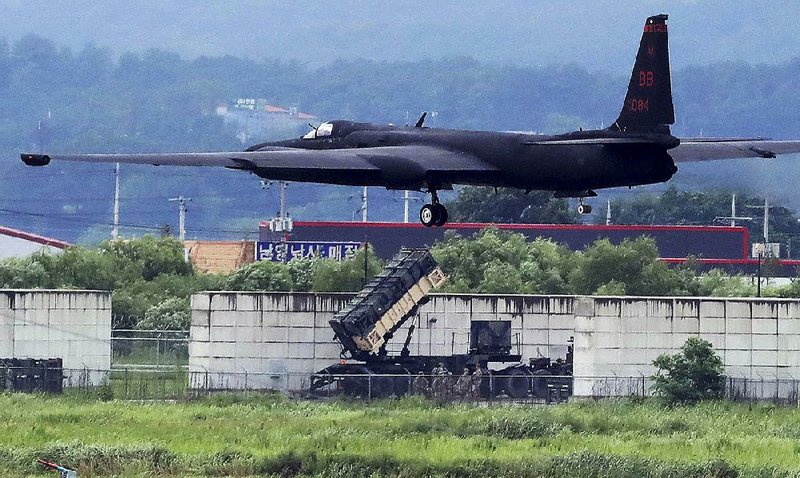SEOUL, South Korea -- The United States and South Korea kicked off their annual joint military exercises on Monday, and North Korea warned that the drills would deepen tensions on the Korean Peninsula by "throwing fuel onto fire."
The Ulchi Freedom Guardian drills are largely computer-simulated war games held every summer and have drawn furious responses from North Korea, which views them as an invasion rehearsal. Pyongyang's state media on Sunday called this year's drills a "reckless" move that could trigger the "uncontrollable phase of a nuclear war."
Despite the threat, U.S. and South Korean militaries launched this year's 11-day training on Monday morning as scheduled. The exercise involves 17,500 American troops and 50,000 South Korean soldiers, according to the U.S. military command in South Korea and Seoul's Defense Ministry.
No field training like live-fire exercises or tank maneuvering is involved in the Ulchi drills, in which alliance officers sit at computers to practice how they engage in battles and hone their decision-making capabilities. The allies have said the drills are defensive in nature.
South Korea's President Moon Jae-in said Monday that North Korea must not use the drills as a pretext to launch fresh provocation, saying the training is held regularly because of repeated provocations by North Korea.
North Korea typically responds to South Korea-U.S. military exercises with weapons tests and a string of belligerent rhetoric. During last year's Ulchi drills, North Korea test-fired a submarine-launched ballistic missile that flew about 310 miles in the longest flight by that type of weapon. Days after the drills, the North carried out its fifth and biggest nuclear test to date.
Last month North Korea test-launched two intercontinental ballistic missiles at highly lofted angles, and outside experts say those missiles can reach some U.S. parts like Alaska, Los Angeles or Chicago if fired at normal, flattened trajectories. Analysts say it would be only a matter of time for the North to achieve its long-stated goal of acquiring a nuclear missile that can strike anywhere in the United States.
Earlier this month, President Donald Trump pledged to answer North Korean aggression with "fire and fury." North Korea threatened to launch missiles toward the American territory of Guam before its leader Kim Jong Un backed off, saying that he would "watch a little more the foolish and stupid conduct of the Yankees" before deciding whether to approve his military's plan to fire missiles near Guam. Kim said the United States needed to "make a proper option first and show it through action" to reduce tensions.
If North Korea uses the drills this week as a reason to launch missiles around Guam or elsewhere, it could set off a new cycle of escalation.
"We have no intention of raising military tensions on the Korean Peninsula," Moon said on Monday during a meeting with his staff. "North Korea should not use this as a pretext for provocation."
On Sunday, the North's main state-run newspaper, Rodong Sinmun, likened the drills to an act of "throwing fuel onto fire" that would "worsen the situation."
"No one can guarantee that this will not escalate into a real war," it said, calling the annual drills a "rehearsal for nuclear war" and the "most naked expression of hostility" toward the North.
North Korea has long accused the Ulchi Freedom Guardian drills and larger springtime joint exercises of raising tensions and has offered to freeze its nuclear and missile tests if they are suspended. China backs that proposal. But Seoul and Washington have rejected the offer, calling the drills legitimate defense exercises that they have conducted for decades.
On Guam, tourists lined up at popular restaurants Monday morning and went for swims in Tumon Bay.
Officials there said the threat level remained normal despite the war games. "Our office has not received official statement warranting any concern for imminent threat to Guam or the Marianas," said George Charfauros, the adviser to the Guam Homeland Security agency, referring also to a neighboring island chain.
"The rhetoric out of North Korea regarding the exercise is similar to what they have done in the past and continue to do with each joint exercise between South Korea, the United States and its allies," according to a statement from Guam Homeland Security and Office of Civil Defense on Monday.
B-1 bombers based at Andersen Air Force Base on Guam fly regular missions to the Korean peninsula, which provokes anger from the North. The "air pirates of Guam again appeared in the sky above South Korea to stage a madcap drill simulating an actual war," the command of the Strategic Force of North Korea's military, which controls its missile program, said this month in warning that it was drawing up plans to launch four intermediate-range ballistic missiles toward the territory.
Information for this article was contributed by Hyung-Jin Kim of The Associated Press and by Choe Sang-Hun and Austin Ramzy of The New York Times.
A Section on 08/22/2017

